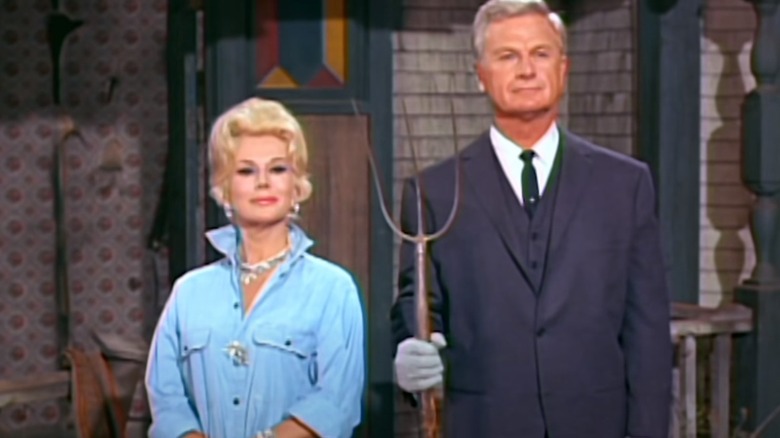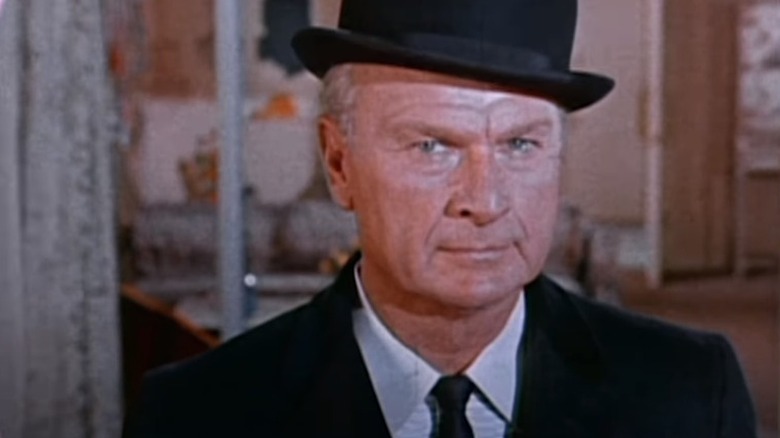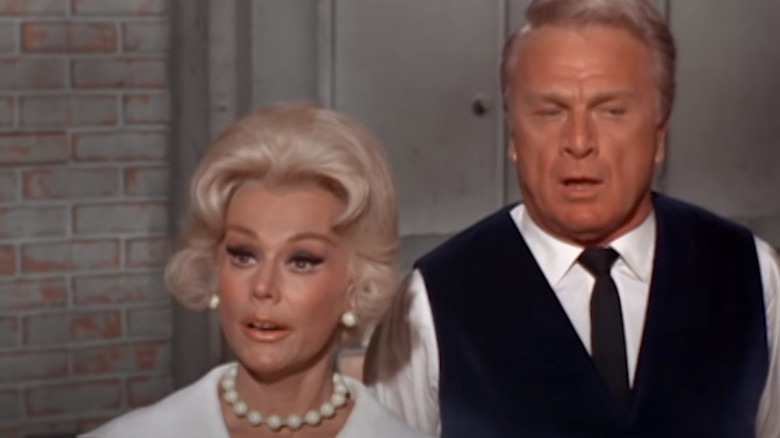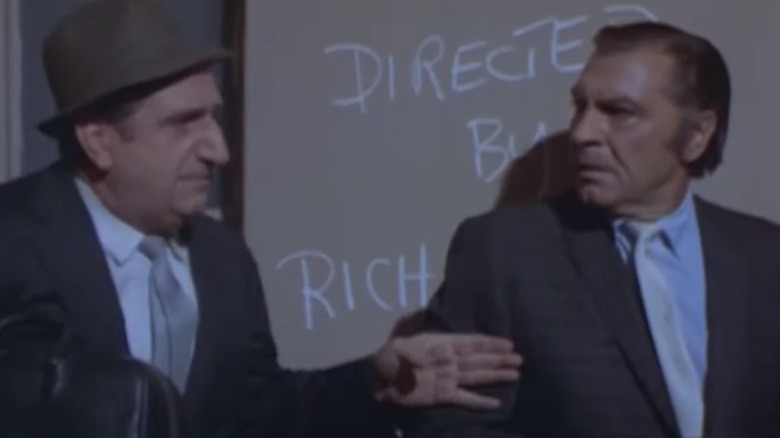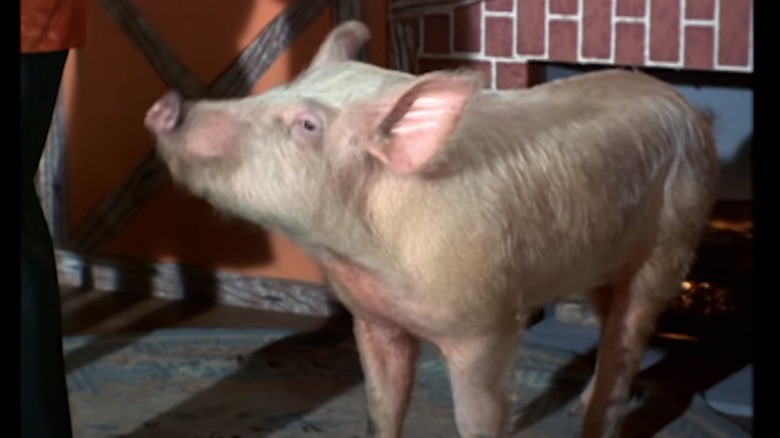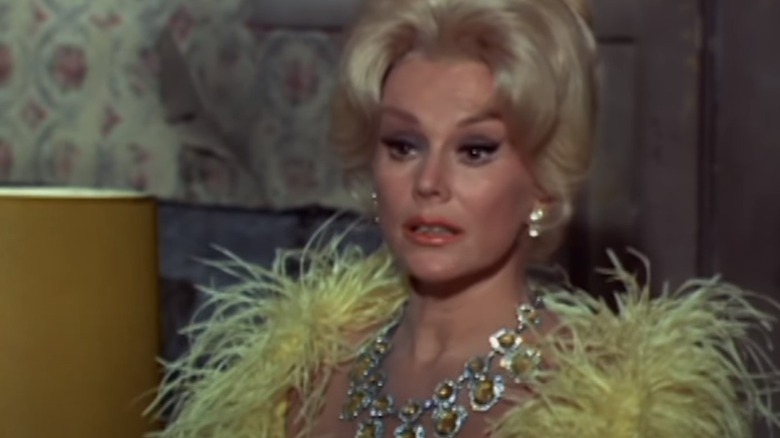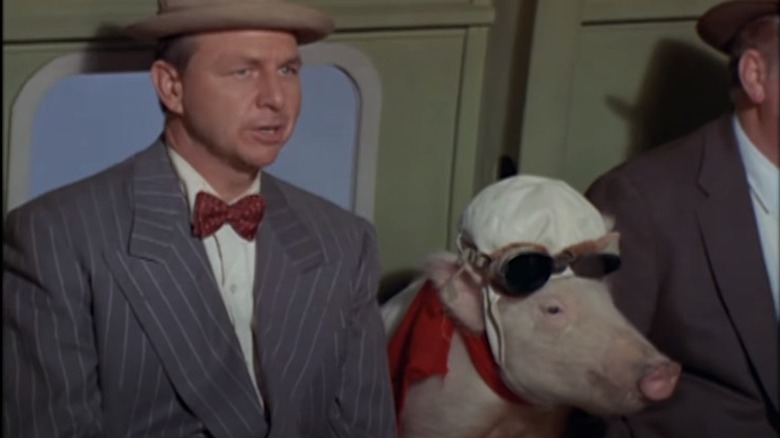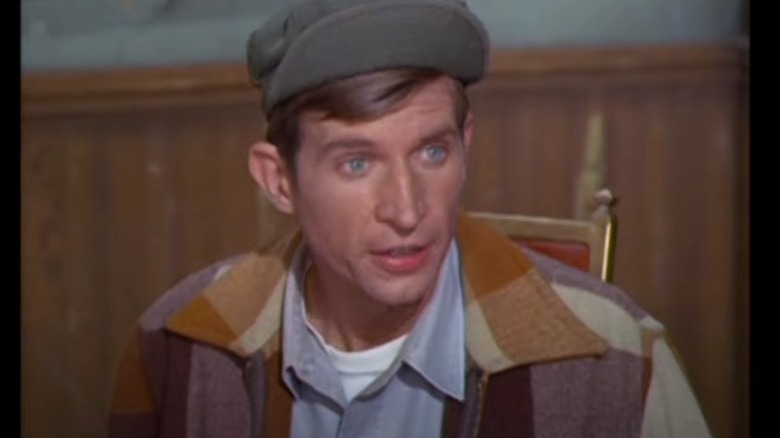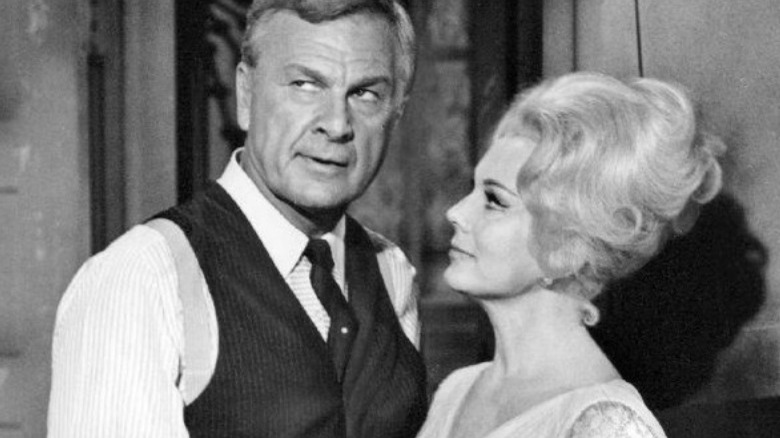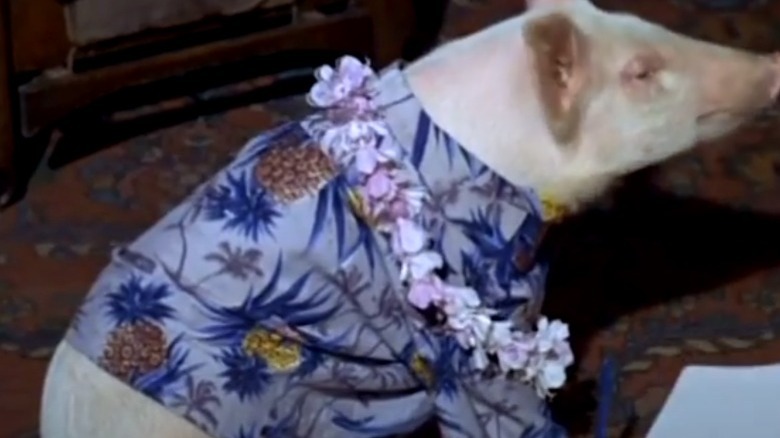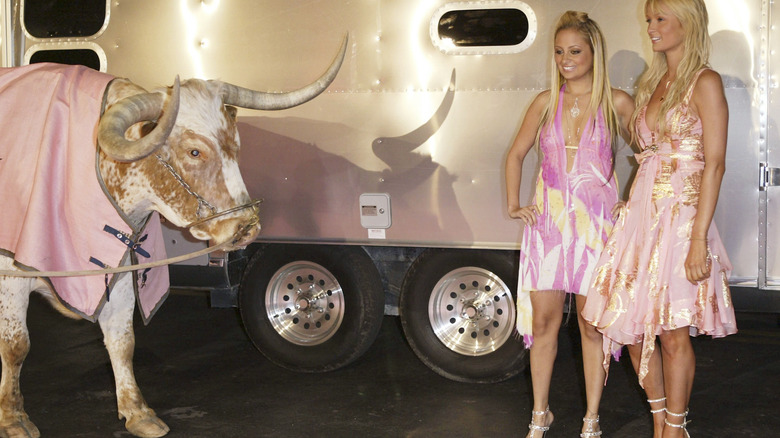The Untold Truth Of Green Acres
"Green Acres": It was definitely the place to be ... at least for half an hour at a time, over the course of the 170 episodes that first aired between 1965 and 1971 ... and in perpetuity since. It's really no wonder that it's remained pretty popular, because there really is something to the idea. No matter how much of a self-professed city-slicker someone is, there's still something undeniably inviting about the prospect of living somewhere with fresh air, infinite greenery, more than a few animals, and fresh veg right from the garden ... especially post-2020. That is, of course, the premise: A husband and wife move from the big city to the country, and hilarity — usually over their ineptitude — ensues.
While most people might remember the television show, it didn't start out that way. According to Sitcom Queens, the show was based on a radio show — also created by show writer Jay Sommers — that debuted in 1950. It was called "Granby's Green Acres," and the Granby in question was a banker instead of a lawyer. The premise was the same, and the television show ended up being much, much more successful.
Still, even those who know the theme song by heart and dream of having their very own pet pig named Arnold still might not know these obscure facts about this classic TV sitcom.
Green Acres starred a World War II spy
By the time Eddie Albert starred as "Green Acres" lawyer-turned-farmer Oliver Wendell Douglas, he'd already had a long career. His film debut came in 1938, says IMDb, but like so many others, things kind of got put on hold during World War II ... for a reason that sounds completely fictional.
According to Military.com, Albert's early jobs included things like a nightclub singer and a trapeze artist — which ended up being incredibly fortunate. When Albert enlisted at the start of the war, he was sent to Mexico with a touring circus. It was just a cover: His real purpose there was to gather information and photographs of German troop movements in the area.
Later, he ended up serving first in the Navy and then the Navy Reserve, and was on the front lines of the Battle of Tarawa. For those not up on their History, the 1943 conflict marked the start of the U.S.'s offensive in the Pacific. Around 18,000 Marines were sent to capture a Japanese stronghold in the Tarawa Atoll, and things did not go well: The U.S. suffered nearly as many casualties in those 76 hours as they did in the six months of the Guadalcanal campaign. Albert was in the first wave and spent all three days in the thick of things. He was ultimately awarded a Bronze Star and was credited with directly rescuing 77 men from what had seemed like certain death after a beach landing gone bad.
Eva Gabor had sworn off jewelry after a harrowing encounter
Eva Gabor's long-suffering city woman had all the glitz and glamour to be expected. That included some serious — and seriously impractical — jewelry, but the bizarre thing is that in real life, a violent robbery had made Gabor swear off jewelry entirely.
On Jan. 5, 1964, The New York Times reported that Gabor and her husband had been attacked in Florida, beaten, bound, and left in their apartment. Two men had stolen her jewelry — which included a $25,000 ring — in an attack that included hitting her with a pistol. She was admitted to the hospital with injuries, including a concussion, and — according to what she told the Star Tribune (via MeTV) — cuts to her ears where her earrings were removed by force. Saying, "I was a little hysterical, but not frightened," Gabor added that she had made a vow never to wear jewelry again, wryly adding, "When my concussion gets better, and I am thinking more clearly, maybe I will change my mind."
Later, Gabor was in New York when she participated in a line-up as a part of the case against then-alleged jewel thieves Jack Murphy and Allan Kuhn. While it's unclear whether or not they were the ones who assaulted Gabor and her husband, Vanity Fair says it ended up playing a part in one of the biggest jewel thefts in the country. Still, Gabor refused to show up for the actual trial: She was in the middle of filming "Green Acres."
A classic TV character actor got his start in season 4 ... at the age of 50
Fans of classic TV will absolutely recognize Al Molinaro, perhaps most famous for his prominent roles in "Happy Days" and "The Odd Couple." But MeTV says that both of those shows might have looked very different, if it wasn't for an episode of "Green Acres" called "A Prize in Every Package." It revolved around Lisa Douglas (Eva Gabor) finding stolen jewels in her cereal, and one of the thieves who had stolen it was Molinaro, in his first television credit.
Proving that it's never too late to go ahead and chase those dreams, Molinaro was 50 years old when he appeared in "Green Acres." According to his obituary in The Guardian, he had started out playing clarinet in dance bands before trying to break into acting. It would be 15 years between a bit part in a 1954 movie and "Green Acres," during which time he opened his own debt collection agency, reinvested the profits, and became pretty rich.
Molinaro remained good friends with many of his co-stars even after their shows had gone the way of late-night reruns, and CBS says that he officially retired in the 1990s, and passed away in 2015 at the completely respectable age of 96.
Don't worry: They didn't eat Arnold
That whole thing about not working with kids or animals is more of a guideline than a rule, because at least one of them is unfailingly cute ... which brings us to "Green Acres" and Arnold, the pig that was much better at country living than at least a few of his fellow humans.
Snopes says that rumors of Arnold's untimely demise have circulated for decades, with even print outlets repeating the claim that after the show ended, the cast and crew roasted Arnold, then enjoyed a little pulled pork. They also say, though, that it's absolutely not true — and that's according to animal trainer Frank Inn.
Inn says that there were multiple pigs that played Arnold, because naturally, pigs get pretty big pretty quickly. Every single one was allowed to live out their lives on a farm when they got too big to be used on set ... and no, not that kind of farm where they tell kids that old dogs and cats "retire" to. Reportedly, it was the first pig who played Arnold who held a special place in Inn's heart: When Arnold Number One passed away in 1972, he was cremated and later put into Inn's casket and buried with him when he passed away in 2002 (via Find a Grave).
Green Acres was the first show where the actors sang the theme song
There are a ton of shows where the actors also sing the theme song: "Fresh Prince of Bel-Air," "Frasier," "The Drew Carey Show," "New Girl," and the list goes on (via ScreenRant). The very first to do it? "Green Acres."
Rare says that Eva Gabor, in particular, wasn't super thrilled with the idea of singing, but after getting some guidance from the songwriter on what he had in mind for the theme — spoiled city socialite — she did it in a single take.
Also noteworthy is who that songwriter was. The theme song for "Green Acres" is so catchy that even people who haven't seen the show can probably still sing it, and there's a reason for it: It was written by Vic Mizzy (pictured), who also wrote the equally earworm-y theme song from "The Addams Family." (And that's Mizzy singing on "The Addams Family" tune, too — three times, then dubbed together because the studio didn't want to spring for multiple singers.) The Brooklyn-born Mizzy wrote a slew of music for television, movies, and singers including Dean Martin, Billie Holiday, and Doris Day (via The Guardian). He passed away in 2009, at 93 years old.
Eva Gabor's costumes were tricky to make ... literally
Part of the ridiculousness of "Green Acres" was the clothes: Driving a tractor and farming while wearing suits and the most dramatic of couture fashion? Why not!
Eva Gabor's wardrobe was the work of costume designer Nolan Miller, who had a few tricks up his sleeve for creating her dramatic looks. One was the store called Loehmann's, which Gabor discovered and Miller reached out to. He told the Television Academy that Loehmann's started buying all the designer samples that they could and sending them to the set, giving Miller and Gabor their choice. The problem? Most were a size 2, and Gabor wore an 8. That meant things were sort of sliced apart and pieced back together, with ostrich feathers being particularly important. The show's single seamstress was tasked with removing feathers from one outfit and sewing them onto another ... again, and again, and again.
And, Miller added, all of that work was made even more difficult by the fact that their clothing budget quickly got cut to $500 per episode. That's not much to outfit a socialite in designer clothes, and it ended up that Gabor and Miller worked together so much on Lisa Douglas' clothes that they formed a lifelong, real-life friendship.
Arnold predates Green Acres
Arnold the pig is arguably more famous than any of "Green Acres" human stars, and it's no secret that he completely stole the show. He even took home some major awards ... for animal performers, sure, but still, that's not too shabby!
Here's perhaps the strangest thing about Arnold and his status as a "Green Acres" fan favorite: MeTV makes a case for the idea that the show was actually a spin-off, made for and starring everyone's favorite plucky porcine. The first time Arnold was on-screen wasn't on "Green Acres" at all — it was on a Season 2, 1965 episode of "Petticoat Junction." IMDb also lists "Green Acres" as a "Petticoat Junction" spin-off, as they were both set in the town of Hooterville. And Arnold became a leading ... pig ... in the fall of 1965, so can "Green Acres" technically be called his spin-off? Sure!
That could also explain why he made the big bucks: Arnold was paid a whopping $250 a day, and in 2021, that's the equivalent of about $1,900 — or, $100,000 a year. That's not too big from a pig who — fun fact — hailed from Mooresville, Indiana. Sound familiar? It might — the pigs that played Arnold share their hometown with John Dillinger.
Tom Lester was the real deal
The running gag of "Green Acres" was, of course, the ineptitude of the city slickers. There was, however, one cast member in particular who was the real deal: farmhand Eb. He was played by Tom Lester, a Hollywood hopeful who had grown up on a farm in Mississippi, earned a degree in chemistry, and taught in Oklahoma for a bit before deciding to try his luck in the entertainment industry. According to Variety, there was one bit of information that cinched his audition: He was the only applicant who knew how to milk a cow.
Lester was kind of a real-life counterpart to his "Green Acres" character, and according to a 1969 article on him from UPI/Rome News-Tribune, he lived the simple life. Specifically, in a furnished, above-a-garage apartment while filming the show, and during the downtime, he toured the country as an evangelical speaker. (He even spent some time as a part of Billy Graham's entourage.)
Lester appeared in a few other productions — including "Benji" — before settling back down into the rural life that he spoke about missing while he was filming "Green Acres." The Clarion-Ledger reported that he was a staunch conservationist, managed his own farm, and in 1997, was honored with Mississippi's Wildlife Farmer of the Year award. When he passed away in 2020 at the age of 81, he was the last surviving member of the show's cast, and the official cause of his death was complications from Parkinson's.
Green Acres ultimately got cancelled for a strange reason
When "Green Acres" got canceled, it was still going strong. So, what happened? An article in Socionomist took a look at exactly what happened, and it turns out that "Green Acres" wasn't alone. During the 1970-71 television season, CBS promoted a new head of programming — and it was his idea not just to replace a few shows that were failing, but to overhaul the network's entire lineup into something new, fresh, and revolutionary ... that, Wide Open Country adds, was more likely to attract the demographic that their most prized advertisers were chasing.
The result was the so-called "Rural Purge," and it's best explained by "Green Acres" actor Pat Buttram, who said, "It was the year CBS canceled everything with a tree — including 'Lassie.'" He wasn't kidding, either: The show that spawned "Green Acres" — "Petticoat Junction" — was the first to go, and it was replaced with "The Mary Tyler Moore Show." When that was a rousing success, the writing was on the wall — even though "Green Acres" was the most popular show in its time slot.
"Green Acres" was the second to go, and MeTV says that others — on all the main networks — soon followed. "Mayberry RFD," "The Beverly Hillbillies," "HeeHaw," "Gunsmoke," "Bonanza," and even "Hogan's Heroes" were deemed to be a part of the last generation of television, and were out.
Eddie Albert turned into an actual farmer
By the time he signed on to "Green Acres," Eddie Albert was already well-established in film — and he'd already made it clear that he wasn't interested in TV. However, he was interested in farming, telling TV Guide (via MeTV): "Everyone gets tired of the rat race. Everyone would like to chuck it all and grow some carrots."
Albert continued farming long after "Green Acres" was canceled and his city-slicker alter ego had hung up his boots. In a 1994 interview with the Buffalo News, Albert talked about how he continued to grow crops, including beans and corn on his front lawn. The 86-year-old Albert had been studying Native American techniques, saying, "The more we learn from them, the longer we'll live." (That home, says the Los Angeles Times, was Albert's California hacienda: He lived there for around 50 years, and in 2017, it went up for sale for $19.5 million.)
Albert was also a vocal supporter of environmentally conscious farming and teaching the younger generations to appreciate farm life. Since 1972, the Champaign Park District has run a program called The Eddie Albert Garden Plots, which established community gardens for locals and community groups — like the 4-H — to use. Mental Floss says that Albert also established a program called City Children's Farms — which, as the name suggests, creates gardens for city families — and was instrumental in the investigation and subsequent banning of the pesticide DDT.
Green Acres' final episodes weren't actually episodes
There was no reason to think that "Green Acres" was going to be canceled — according to MeTV, they were dominating the ratings for their time slot. It's not entirely surprising, then, that there was nothing filmed as a wrap-up finale. There were two pseudo-finale episodes aired, and the weird thing is that at the time, they weren't finales at all: They were introducing planned spin-offs.
The first episode was "Hawaiian Honeymoon," which has Eva Gabor and Eddie Albert heading to Hawaii for their characters' fifth honeymoon. The important part, though, was the hotel they stayed at, which was going to be the setting for a new show about the hotelier and his daughter.
The second episode had Albert's Douglas mailing a letter to his one-time secretary, asking about the name of a jeweler. She's since moved to Los Angeles and gotten a job at a realty company, which is what the rest of the episode is about. Neither show got picked up — which MeTV says likely had something to do with the programming overhaul that saw "Green Acres" get canceled — and were instead a strange ending to an admittedly already strange show.
Green Acres inspired The Simple Life
"Green Acres" may have been canceled prematurely, but it's lived on in a weird way — one that hasn't really aged as well as the original series. According to a TV Week interview with executives at Fox, the idea for Paris Hilton and Nicole Ritchie's show about two rich, entitled girls being unable to complete basic tasks most humans need for day-to-day survival was inspired by "Green Acres."
"The Simple Life" saw Hilton and Ritchie heading off to spend a month living on a farm in Arkansas and being confused — and it all happened after execs decided to go back to the 1960s and 70s to find sitcom concepts to turn into reality TV. They settled on "Green Acres" to give the whole thing a go, and while it was wildly successful at the time, Glamour notes that it hasn't aged well. The basis of the show was cruelty: Ridiculing people for their ordinary lives, causing problems in the sorts of jobs that are a very real livelihood for countless people, and relying heavily on what they call "exploitation culture."
Bottom line? Sometimes, the original really is better.
